Good Shepherd
The Good Shepherd (Greek: ποιμήν ὁ καλός, poimḗn ho kalós) is an image used in the pericope of John 10:1–21, in which Jesus Christ is depicted as the Good Shepherd who lays down his life for his sheep. Similar imagery is used in Psalm 23. The Good Shepherd is also discussed in the other gospels, the Epistle to the Hebrews, the First Epistle of Peter and the Book of Revelation.

Biblical references
In the Gospel of John, Jesus states "I am the good shepherd" in two verses, John 10:11 and 10:14.
I am the good shepherd. The good shepherd lays down his life for the sheep. He who is a hired hand, and not a shepherd, who doesn't own the sheep, sees the wolf coming, leaves the sheep, and flees. The wolf snatches the sheep, and scatters them. The hired hand flees because he is a hired hand, and doesn't care for the sheep. I am the good shepherd. I know my own, and I'm known by my own; even as the Father knows me, and I know the Father. I lay down my life for the sheep. I have other sheep, which are not of this fold. I must bring them also, and they will hear my voice. They will become one flock with one shepherd. Therefore the Father loves me, because I lay down my life, that I may take it again. No one takes it away from me, but I lay it down by myself. I have power to lay it down, and I have power to take it again. I received this commandment from my Father.
This passage is one of several sections of John's Gospel which generate division among the Jews.[John 10:19–21]
Jesus Christ is also compared to a shepherd in Matthew 2:6, Matthew 9:36, Matthew 25:32, Matthew 26:31, Mark 6:34, Mark 14:27, John 10:2, Hebrews 13:20, 1 Peter 2:25, 1 Peter 5:4, and Revelation 7:17.
Parable or metaphor?
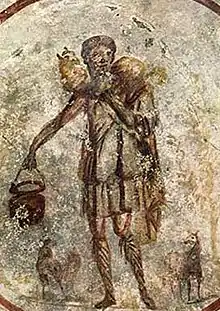
Several authors such as Tinto, Barbara Reid, Arland Hultgren or Donald Griggs comment that "parables are noticeably absent from the Gospel of John".[2][3][4] According to the Catholic Encyclopedia article on Parables:[5] "There are no parables in St. John's Gospel" and according to the Encyclopædia Britannica article on Gospel of St. John:[6] "Here Jesus' teaching contains no parables and but three allegories, the Synoptists present it as parabolic through and through."
Early Christian art
The image of the Good Shepherd is the most common of the symbolic representations of Christ found in early Christian art in the Catacombs of Rome, before Christian imagery could be made explicit. The form of the image showing a young man carrying a lamb round his neck was directly borrowed from the much older pagan kriophoros (see below) and in the case of portable statuettes like the most famous one now in the Pio Cristiano Museum, Vatican City (right), it is impossible to say whether the image was originally created with the intention of having a Christian significance. The image continued to be used in the centuries after Christianity was legalized in 313. Initially it was probably not understood as a portrait of Jesus, but a symbol like others used in Early Christian art,[7] and in some cases may also have represented the Shepherd of Hermas, a popular Christian literary work of the 2nd century.[8][9] However, by about the 5th century, the figure more often took on the appearance of the conventional depiction of Christ, as it had developed by this time, and was given a halo and rich robes,[10] as on the apse mosaic in the church of Santi Cosma e Damiano in Rome, or at Ravenna (right). Images of the Good Shepherd often include a sheep on his shoulders, as in the Lukan version of the Parable of the Lost Sheep.[11]
Pagan symbolism
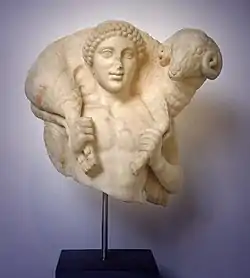
In ancient Greek cult, kriophoros or criophorus (Κριοφόρος), the "ram-bearer" is a figure that commemorates the solemn sacrifice of a ram. It becomes an epithet of Hermes: Hermes Kriophoros.
In two-dimensional art, Hermes Kriophoros transformed into the Christ carrying a lamb and walking among his sheep: "Thus we find philosophers holding scrolls or a Hermes Kriophoros which can be turned into Christ giving the Law (Traditio Legis) and the Good Shepherd respectively".[12] The Good Shepherd is a common motif from the Catacombs of Rome (Gardner, 10, fig 54) and in sarcophagus reliefs, where Christian and pagan symbolism are often combined, making secure identifications difficult. This is defined as syncretism, a blending of images from different cultures and religions.
Gallery
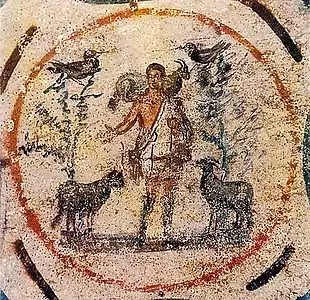 At the Catacomb of Priscilla, Rome
At the Catacomb of Priscilla, Rome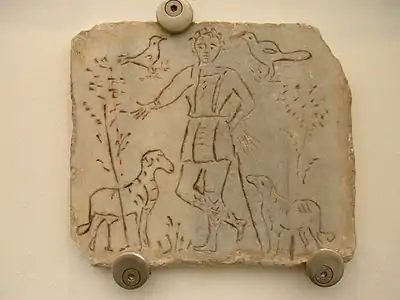 Fourth-century depiction at the Museum of the Baths of Diocletian, Rome
Fourth-century depiction at the Museum of the Baths of Diocletian, Rome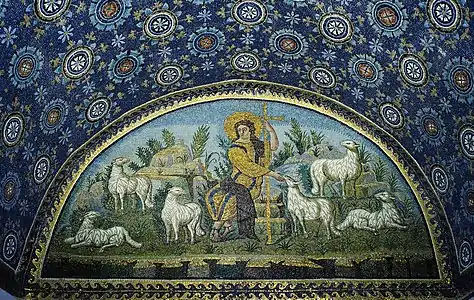 Mosaic in the Mausoleum of Galla Placidia, Ravenna, Italy, ca. 425
Mosaic in the Mausoleum of Galla Placidia, Ravenna, Italy, ca. 425 Christ as the Good Shepherd, unknown artist from Lower Bavaria, 1750
Christ as the Good Shepherd, unknown artist from Lower Bavaria, 1750
 19th century by German Artist Bernard Plockhorst
19th century by German Artist Bernard Plockhorst 20th-century stained glass depiction, Australia
20th-century stained glass depiction, Australia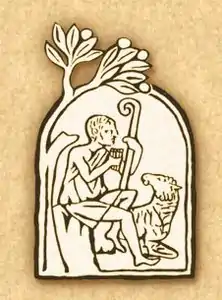 Emblem of the Catechism of the Catholic Church
Emblem of the Catechism of the Catholic Church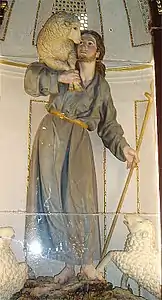 Oratorio de la Santa Cueva. Cádiz, España
Oratorio de la Santa Cueva. Cádiz, España.jpg.webp) Jesus as a shepherd boy, Church of the Good Shepherd (Rosemont, Pennsylvania)
Jesus as a shepherd boy, Church of the Good Shepherd (Rosemont, Pennsylvania)
See also
References
Citations
- Grabar 1980:The figure (...) is an allegory of Christ as the shepherd
- Reid 2001, p. 3.
- Hultgren 2000, p. 2.
- Griggs 2003, p. 52.
- Barry 1911.
- von Hügel 1911, pp. 452–458.
- Syndicus 1962, pp. 21-23.
- Jensen 2002.
- Jensen 2000, pp. 37-41.
- Syndicus 1962, pp. 130–131.
- Lowrie 2007, p. 69.
- Murray & Murray 1996, p. 475.
Sources
- Barry, William (1911). . In Herbermann, Charles (ed.). Catholic Encyclopedia. 11. New York: Robert Appleton Company.
- Grabar, André (1980). Christian Iconography: A Study of Its Origins. Routledge & Kegan Paul.CS1 maint: ref=harv (link)
- Griggs, Donald L. (2003). The Bible from Scratch: The New Testament for Beginners. Westminster John Knox Press. ISBN 978-0-664-22577-3.CS1 maint: ref=harv (link)
- Hultgren, Arland J. (2000). The Parables of Jesus: A Commentary. Wm. B. Eerdmans. ISBN 978-0-8028-6077-4.CS1 maint: ref=harv (link)
- Jensen, Robin Margaret (2000). Understanding Early Christian Art. Psychology Press. ISBN 978-0-415-20454-5.CS1 maint: ref=harv (link)
- Jensen, Robin M. (October 2002). "The Two Faces of Jesus". Bible Review. Vol. 17 no. 8.
- Lowrie, Walter (March 2007). Art in the Early Church. Read Books. ISBN 978-1-4067-5291-5.CS1 maint: ref=harv (link)
- Murray, Peter; Murray, Linda (1996). The Oxford Companion to Christian Art and Architecture. Oxford University Press. ISBN 978-0-19-866165-8.CS1 maint: ref=harv (link)
- Reid, Barbara E. (2001). Parables for Preachers: The Gospel of Matthew : Year A. Liturgical Press. ISBN 978-0-8146-2550-7.CS1 maint: ref=harv (link)
- Syndicus, Eduard (1962). Early Christian Art. Burns & Oates.CS1 maint: ref=harv (link)
- von Hügel, Friedrich (1911). . In Chisholm, Hugh (ed.). Encyclopædia Britannica. 15 (11th ed.). Cambridge University Press. pp. 452–458.
External links
- Holman Bible Dictionary – "Shepherd" for other Biblical references.
| Wikimedia Commons has media related to Good Shepherd. |